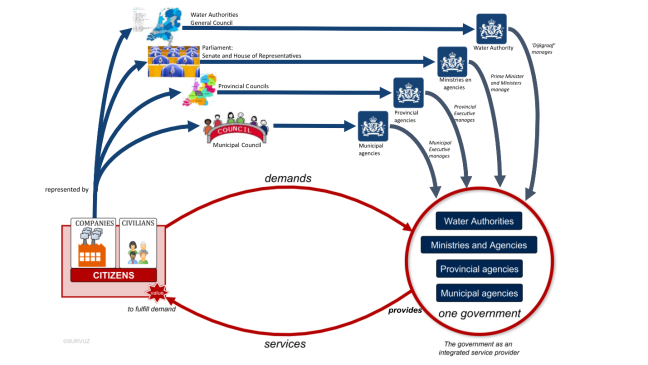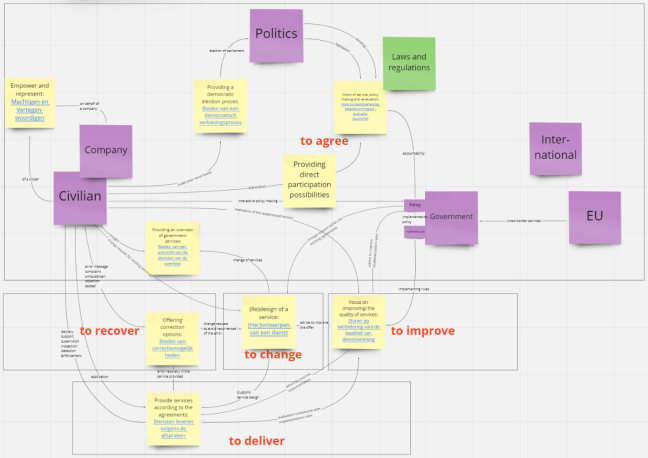Description
What are the benefits of fostering interoperability within the country?
One of the main objectives of the Netherlands in promoting interoperability is to facilitate the sharing of knowledge within the public sector, as well as to provide facilities to ensure interoperability on all five views (or layers) of the Dutch Interoperability framework, i.e. the foundation layer; the organizational layer; the information layer; the application layer; and the network layer.
See Vijflaagsmodel - NORA Online for further information.
What are the measures put in place to ensure compliance with the EIF?
In order to support the design of EU cross-border services, the EIF recommendations have been considered in detail and compared with existing principles and recommendations of the NORA. This has led to conclude that the NORA is highly aligned with the EIF. The use of NORA is mandatory for all governmental organisations since 2008.
See Alignment NORA en EIF - NORA Online for further information.
How is interoperability concretely fostered in the frame of this concrete example/good practice?
By gathering knowledge from several experts in the design of digital services, NORA supports the creation of domain-specific architectures with information such as architecture principles, themes for new developments, standards, specifications and useful building blocks. The platform is maintained by governmental and commercial organizations and includes several communities that share their knowledge, insights and agreements on current topics such as privacy, security, case management, semantics and mobility. These communities are related to various sectors, including education, healthcare and social security. Each domain has its own (reference) architecture.
The NORA governance is based on a good balance between functional demand and supply of means. The representatives of the domain-specific architectures and the different communities meet every few months as part of an architecture council. The main objective is to agree on what should be shared on the platform to foster better service design and interoperability within the public sector. At these meetings, the representatives of NORA make proposals for future developments. Major changes to NORA follow a “public review” process conducted according to the Management and Development Model for Open Standards (BOMOS). BOMOS is a methodology for the management and further development of standards in the Netherlands.
Interoperability is safeguarded by two specific measures and the architectural principles play a key role in this:
- General policies regarding the governmental services, among which EU regulations, are analyzed every year by expert groups in order to abstract the quality goals for the public services from it.
These goals are then linked with the architectural principles.
This provides general and societal direction when (re)designing public services.
See Kwaliteitsdoelen - NORA Online
- The architectural principles are also worked out in operational implications, among which is the use of specific standards.
Each of these implications is linked to exactly one view of the Dutch five-layered Interoperability Framework.
This provides practical and concrete help when (re)designing and deploying public services.
See Architectuurprincipes - NORA Online
What type of ISA² solutions or CEF building blocks have been reused or leveraged to implement this concrete example/good practice?
As several Dutch governmental organizations work within an international context, NORA has created an “International Architecture” section which includes information about the EIF and the European Interoperability Reference Architecture (EIRA) to ensure international coordination and deployment of interoperable cross-border services.
See Architectuur internationaal - NORA Online
However, this part in NORA is not much used yet, as most cross-border services are still to be designed, which is done in EU programmes and by following the principles and building blocks used in the specific EU-domains like e-Health and Procurement (instead of the EIF / EIRA promoted by ISA).
Main takeaways
What are the success factors of this concrete example/good practice?
The explanatory factor for the Netherlands’ success in fostering interoperability is community management and the sharing of knowledge and information through the NORA platform. This ensures effective cooperation between governmental service providers and optimal reuse of existing solutions.
What are the key lessons learned from this concrete example/good practice?
According to the Netherlands, EU programmes for cross-border services, such as the Single Digital Gateway, should reuse the architectural solutions that are provided by the ISA² programme of the European Commission (i.e. EIF and EIRA) as much as possible.
In addition, information on cross-border services is scattered throughout many different European websites, making it difficult for everyone to find the information they need.
The Netherlands, therefore, suggests that the EIF and EIRA should be repositioned in the single European Architectural Knowledge Platform that supports all NIFs by means of a semantic Wiki.
Related solution(s)
We have recently improved our conceptual model for integrated public services.
The figure below is the highest level of abstraction and shows the public needs (demands from citizens and businesses), the governmental response to these needs (services), and the societal governance of the whole (our democracy, i.e. citizens elect the representatives responsible for providing the services).

This highest level of abstraction is reflected in the figure below, which describes the eight capabilities that the Dutch government needs in order to deliver good services to civilians and companies, and consequently fulfil its role as a service provider to Dutch society.

In the above figure, the purple blocks represent the parties involved in the eight capabilities, i.e. citizens (burgers), businesses (bedrijven), politicians (politiek), the government (overheid), the EU and the international level. The five processes of the USM are in bold red. The yellow blocks represent the eight capabilities that the government needs to provide better services.
This capability-overview enables the Dutch government to determine, implement, adjust and continuously improve the service and is based on the Unified Service Management (USM), a standardized management system for service providers. The USM approach allows organizations to act as links in integrated supply chains and networks (value streams) with no more than -again- 8 standardized workflows. The USM approach is already being used by individual governmental agencies and municipalities for the improvement of their services and their service management.
We expect that this improved conceptual model can also be used by other countries as well as by the EU in order to design and describe all cross-border services in the European Union.
Of course, this Dutch example of integrated public services first needs translation (in English) and some further explanation. Some content is already available in English, but this translation should be further expanded.
See Dienstverleningsconcept - NORA Online
How it supports the implementation of the EIF recommendation(s)?
The EIF recommendations have been considered in detail and have been compared with existing principles and recommendations of the NORA. This has led to the conclusion that the NORA is highly aligned with the EIF.
As the use of NORA is mandatory for all governmental organizations since 2008, the use of the EIF is consequentially ensured if the NORA is applied.
See Xref new EIF and NORA - final 21jul17 (noraonline.nl)
Relevant related websites and documentation
For further information, you could consult:
NORA’s International Architecture
Contact information
Eric Brouwer See also NORA Beheer - NORA Online
eric.brouwer@ictu.nl
+31625081006

